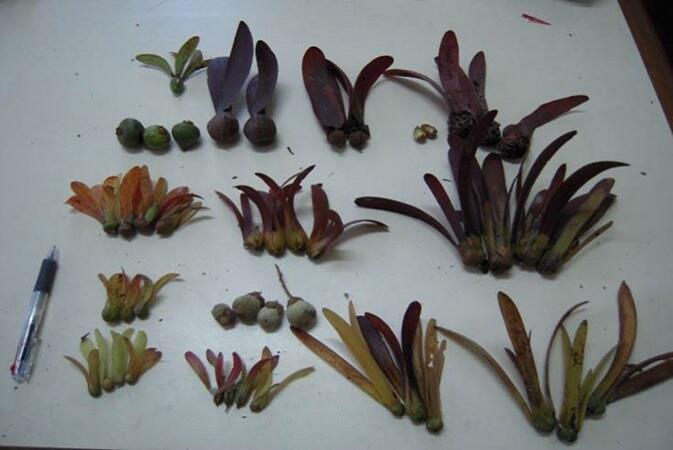An international collaborative team led by Professor Tomoaki Ichie of the Faculty of Agriculture and Marine Science at Kochi University, the Japan International Research Center for Agricultural Sciences, Hong Kong Baptist University, Kyoto University, Okayama University, the Research Institute for Humanity and Nature, and the Sarawak Forest Department in Malaysia announced their discovery that in 18 tree species of Dipterocarpaceae, dominant in tropical rainforests in Southeast Asia, the contribution of stored carbohydrate resources to seed production is low. Carbon isotopes (14C) in the seeds of 18 Dipterocarpaceae species that participated in a simultaneous bloom in Lambir National Park on the island of Borneo, Malaysia, were analyzed to determine when the carbohydrates in the seeds were produced through photosynthesis. It was found that simultaneous flowering mainly uses recent photosynthesis products in the year in which reproduction occurs. This finding is expected to lead to the establishment of appropriate conservation and management techniques for Southeast Asian tropical rainforests and was published in the international journal Oecologia on March 14.

Provided by Professor Tomoaki Ichie of Kochi Unviersity
In the lowland tropical rainforests of Southeast Asia, a simultaneous flowering and fruiting event occurs every 2-10 years when various tree species bloom and bear fruit synchronously. In particular, many trees of the Dipterocarpaceae family, the dominant tree species, reproduce only in the year of simultaneous flowering and bear fruit in large numbers at that time. The trees are believed to store carbohydrates in their bodies for a long period to allow for simultaneous flowering and fruiting. However, this hypothesis has been hard to prove owing to the difficulty of investigating each tree's storage resources for this irregular reproductive phenomenon.
Carbon in the atmosphere is made up of about 99% of the stable isotope 12C, about 1% of 13C, and very small amounts of 14C. Plants absorb these isotopes for photosynthesis. This study analyzed how carbohydrates are used by examining the concentration of 14C in seeds. The 18 species analyzed varied greatly from species to species, with breeding frequencies ranging from one to six times from 1993 to 2003. The atmosphere originally contained minuscule concentrations of 14C, but these increased dramatically in the 1950s due to atmospheric nuclear testing during the Cold War. The ban on nuclear testing has reduced atmospheric dissolution since 1963. By matching the age of carbon fixation calculated from the 14C in the seeds with the year of their collection, the period of time in years during which the carbon resources used in the seeds have been accumulated can be estimated.
The results showed that contrary to the initial hypothesis, Dipterocarpaceae trees use recent photosynthesis products rather than stored products for seed production, regardless of the frequency of their participation in simultaneous flowering. In years of simultaneous bloom, the diameter growth of Dipterocarpaceae trees is lower than usual. This indicates that the trees can use carbohydrate resources as needed by diverting them from growth to reproduction. Future work to determine the relationship between the accumulation of various nutrients and reproduction in more tree species may reveal factors that limit participation in simultaneous flowering.
To regenerate tropical rainforests in Southeast Asia, which have been rapidly degraded and lost over the past several decades, afforestation using Dipterocarpaceae and other species is being actively conducted. The irregular fruiting of Dipterocarpaceae trees is a challenge for the planned production of seedlings. If predicting the timing of simultaneous flowering and seed production becomes possible, it is expected to lead to the establishment of appropriate conservation and management techniques for Southeast Asian tropical rainforests.
Ichie said, "The simultaneous flowering and fruiting that occurs in the tropical rainforests of Southeast Asia has attracted the attention of researchers worldwide as a mysterious phenomenon. By combining carbon isotope analysis with valuable long-term data on flowering and fruiting frequencies of tropical trees obtained by many researchers, we obtained the present results and clarified one aspect of the mechanism of simultaneous flowering. We will continue to conduct further research to elucidate the full extent of the issue."
Journal Information
Publication: Oecologia
Title: No evidence of carbon storage usage for seed production in 18 dipterocarp masting species in a tropical rain forest
DOI: 10.1007/s00442-024-05527-w
This article has been translated by JST with permission from The Science News Ltd. (https://sci-news.co.jp/). Unauthorized reproduction of the article and photographs is prohibited.




